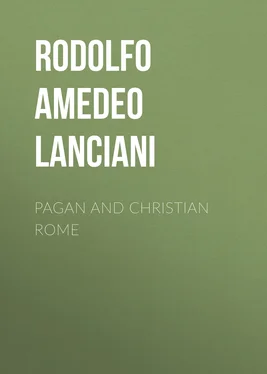Rodolfo Amedeo Lanciani - Pagan and Christian Rome
Здесь есть возможность читать онлайн «Rodolfo Amedeo Lanciani - Pagan and Christian Rome» — ознакомительный отрывок электронной книги совершенно бесплатно, а после прочтения отрывка купить полную версию. В некоторых случаях можно слушать аудио, скачать через торрент в формате fb2 и присутствует краткое содержание. Жанр: foreign_edu, История, История, на английском языке. Описание произведения, (предисловие) а так же отзывы посетителей доступны на портале библиотеки ЛибКат.
- Название:Pagan and Christian Rome
- Автор:
- Жанр:
- Год:неизвестен
- ISBN:нет данных
- Рейтинг книги:3 / 5. Голосов: 1
-
Избранное:Добавить в избранное
- Отзывы:
-
Ваша оценка:
- 60
- 1
- 2
- 3
- 4
- 5
Pagan and Christian Rome: краткое содержание, описание и аннотация
Предлагаем к чтению аннотацию, описание, краткое содержание или предисловие (зависит от того, что написал сам автор книги «Pagan and Christian Rome»). Если вы не нашли необходимую информацию о книге — напишите в комментариях, мы постараемся отыскать её.
Pagan and Christian Rome — читать онлайн ознакомительный отрывок
Ниже представлен текст книги, разбитый по страницам. Система сохранения места последней прочитанной страницы, позволяет с удобством читать онлайн бесплатно книгу «Pagan and Christian Rome», без необходимости каждый раз заново искать на чём Вы остановились. Поставьте закладку, и сможете в любой момент перейти на страницу, на которой закончили чтение.
Интервал:
Закладка:
Other evidence of the conquests made by the gospel among the patricians is given by an inscription discovered in March, 1866, in the Catacombs of Prætextatus, near the monument of Quirinus the martyr. It is a memorial raised to the memory of his departed wife by Postumius Quietus, consul a. d. 272. Here also was found the name of Urania, daughter of Herodes Atticus, by his second wife, Vibullia Alcia, 4 4 A description of the beautiful villa of Herodes, adjoining the Catacombs of Prætextatus, will be found in chapter vi. pp. 287 sqq.
while on the other side of the road, near S. Sebastiano, a mausoleum has been found, on the architrave of which the name URANIOR[UM] is engraved.
In chapter vii. Конец ознакомительного фрагмента. Текст предоставлен ООО «ЛитРес». Прочитайте эту книгу целиком, купив полную легальную версию на ЛитРес. Безопасно оплатить книгу можно банковской картой Visa, MasterCard, Maestro, со счета мобильного телефона, с платежного терминала, в салоне МТС или Связной, через PayPal, WebMoney, Яндекс.Деньги, QIWI Кошелек, бонусными картами или другим удобным Вам способом.
I shall have occasion to refer to many Christian relatives of the emperors Vespasian and Domitian. Eusebius, in speaking of these Flavians, and particularly of Domitilla the younger, niece of Domitian, quotes the authority of the historian Bruttius. He evidently means Bruttius Præsens, the illustrious friend of Pliny the younger, and the grandfather of Crispina, the empress of Commodus. In 1854, near the entrance to the crypt of the Flavians, at Torre Marancia (Via Ardeatina), a fragment of a sarcophagus was found, with the name of Bruttius Crispinus. If, therefore, the history of Domitilla's martyrdom was written by the grandfather of Bruttia Crispina, the empress, it seems probable that the two families were united not only by the close proximity of their villas and tombs, and by friendship, but especially by community of religion.
I may also cite the names of several Cornelii, Cæcilii, and Æmilii, the flower of Roman nobility, grouped near the graves of S. Cæcilia and Pope Cornelius; of Liberalis, a consul suffectus , 5 5 A consul suffectus was one elected as a substitute in case of the death or retirement of one of the regular consuls.
and a martyr, whose remains were buried in the Via Salaria; of Jallia Clementina, a relative of Jallius Bassus, consul before a. d. 161; of Catia Clementina, daughter or relative of Catius, consul a. d. 230, not to speak of personages of equestrian rank, whose names have been collected in hundreds.
A difficulty may arise in the mind of the reader: how was it possible for these magistrates, generals, consuls, officers, senators, and governors of provinces, to attend to their duties without performing acts of idolatry? In chapter xxxvii. of the Apology, Tertullian says: "We are but of yesterday, yet we fill every place that belongs to you, cities, islands, outposts; we fill your assemblies, camps, tribes and decuries; the imperial palace, the Senate, the forum; we only leave to you your temples." But here lies the difficulty; how could they fill these places, and leave the temples?
First of all, the Roman emperors gave plenty of liberty to the new religion from time to time; and some of them, moved by a sort of religious syncretism, even tried to ally it with the official worship of the empire, and to place Christ and Jupiter on the steps of the same lararium . The first attempt of the kind is attributed to Tiberius; he is alleged to have sent a message to the Senate requesting that Christ should be included among the gods, on the strength of the official report written by Pontius Pilatus of the passion and death of our Lord. Malala says that Nero made honest inquiries about the new religion, and that, at first, he showed himself rather favorable towards it; a fact not altogether improbable, if we take into consideration the circumstances of Paul's appeal, his absolution, and his relations with Seneca, and with the converts de domo Cæsaris , "of the house of Cæsar." Lampridius, speaking of the religious sentiments of Alexander Severus, says: "He was determined to raise a temple to Christ, and enlisted him among the gods; a project attributed also to Hadrian. There is no doubt that Hadrian ordered temples to be erected in every city to an unknown god; and because they have no statue we still call them temples of Hadrian. He is said to have prepared them for Christ; but to have been deterred from carrying his plan into execution by the consideration that the temples of the old gods would become deserted, and the whole population turn Christian, omnes christianos futuros ." 6 6 Lampridius, in Sev. Alex. , c. 43.
The freedom enjoyed by the Church under Caracalla is proved by the graffiti of the Domus Gelotiana, described in my "Ancient Rome." 7 7 In chapter v., p. 122, of Ancient Rome , I have attributed these graffiti to the second half of the first century; but after a careful examination of the structure of the wall, on the plaster of which they are scratched, I am convinced that they must have been written towards the end of the second century.
The one caricaturing the crucifixion, which is reproduced on p. 122 of that volume, stands by no means alone in certifying to the spreading of the faith in the imperial palace. The name of Alexamenos, "the faithful," is repeated thrice. There is also a name, LIBANUS, under which another hand has written EPISCOPUS, and, lower down, LIBANUS EPI[SCOPUS]. It is very likely a joke on Libanus, a Christian page like Alexamenos, whom his fellow-disciples had nicknamed "the bishop." It is true that the title is not necessarily Christian, having been used sometimes to denote a municipal officer; 8 8 Orelli, 4024, Digest L. , iv. 18, 7.
but this can hardly be the case in an assembly of youths, like the one of the Domus Gelotiana; and the connection between the graffiti of Libanus and those of Alexamenos seems evident. In reading these graffiti , now very much injured by dampness, exposure, and the unscrupulous hands of tourists, we are really witnessing household quarrels between pagan and Christian dwellers in the imperial palace, in one of which Caracalla, when still young, saw one of his playmates struck and punished on account of his Christian origin and persuasion.
Septimius Severus and Caracalla issued a constitution, 9 9 See Ulpian: De officio Procons. , i. 3.
which opened to the Jews the way to the highest honors, making the performance of such ceremonies as were in opposition to the principles of their faith optional with them. What was granted to the Jews by the law of the empire may have been permitted also to the Christians by the personal benevolence of the emperors.

Portrait Bust of Philip the Younger.
When Elagabalus collected, or tried to collect, in his own private chapel the gods and the holiest relics of the universe, he did not forget Christ and his doctrine. 10 10 Lampridius, Heliog. , 3.
Alexander Severus, the best of Roman rulers, gave full freedom to the Church; and once, the Christians having taken possession of a public place on which the popinarii , or tavern-keepers, claimed rights, Alexander gave judgment in favor of the former, saying it was preferable that the place should serve for divine worship, rather than for the sale of drinks. 11 11 See Greppo: Mémoire sur les laraires de l'empereur Alexandre Sevère .
Интервал:
Закладка:
Похожие книги на «Pagan and Christian Rome»
Представляем Вашему вниманию похожие книги на «Pagan and Christian Rome» списком для выбора. Мы отобрали схожую по названию и смыслу литературу в надежде предоставить читателям больше вариантов отыскать новые, интересные, ещё непрочитанные произведения.
Обсуждение, отзывы о книге «Pagan and Christian Rome» и просто собственные мнения читателей. Оставьте ваши комментарии, напишите, что Вы думаете о произведении, его смысле или главных героях. Укажите что конкретно понравилось, а что нет, и почему Вы так считаете.












